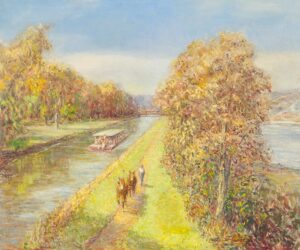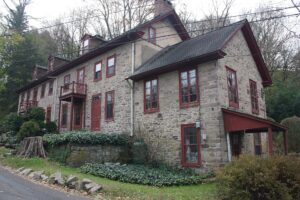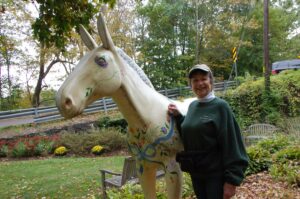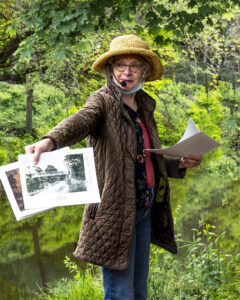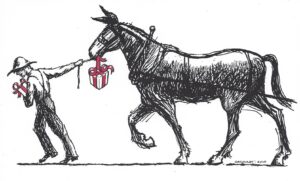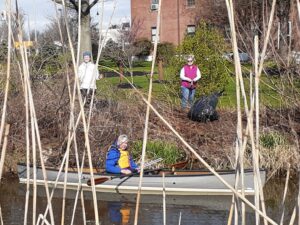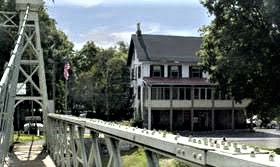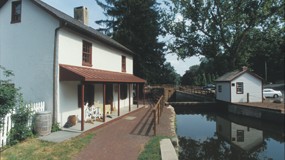Flowers are Everywhere
The Delaware Canal towpath spans 58.9 miles, and in that distance, you can spot many flowering plants along the way. Some are relatively obvious, and others require a keen eye. Here are a
few to look for.
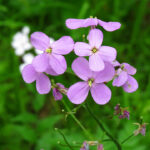 < Dame’s Rocket is a flowering biennial member of the mustard family. This plant has some historical significance as it was recorded as one of the first wildflowers imported to the colonies from Europe. Also known as Sweet Rocket, its fragrance is most pronounced in the evening sometimes confused with Phlox, the flower of Dame’s Rocket has four petals, versus Phlox, which has five. The flowers come in an assortment of spring colors, including white, pink, and purple. It prefers to grow in sunny, moist locations and can be found on the margins of marshes and woodlands. It is considered an invasive species in Pennsylvania.
< Dame’s Rocket is a flowering biennial member of the mustard family. This plant has some historical significance as it was recorded as one of the first wildflowers imported to the colonies from Europe. Also known as Sweet Rocket, its fragrance is most pronounced in the evening sometimes confused with Phlox, the flower of Dame’s Rocket has four petals, versus Phlox, which has five. The flowers come in an assortment of spring colors, including white, pink, and purple. It prefers to grow in sunny, moist locations and can be found on the margins of marshes and woodlands. It is considered an invasive species in Pennsylvania.
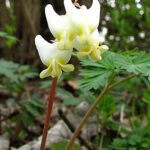 < Dutchman’s Breeches is a perennial herbaceous plant native to eastern North America. This diminutive woodland plant has white flowers that resemble pants hanging from a clothesline. According to the Bowman’s Flower Preserve Native Plant Guide, the flower is an early nectar source for emerging queen bees. As a member of the Dicentra family (bleeding heart), it is also called Little Blue Staggers because it appears to have a narcotic effect on cows causing them to seem drunk.
< Dutchman’s Breeches is a perennial herbaceous plant native to eastern North America. This diminutive woodland plant has white flowers that resemble pants hanging from a clothesline. According to the Bowman’s Flower Preserve Native Plant Guide, the flower is an early nectar source for emerging queen bees. As a member of the Dicentra family (bleeding heart), it is also called Little Blue Staggers because it appears to have a narcotic effect on cows causing them to seem drunk.
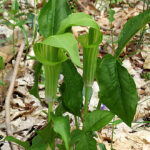 < Jack-in-the-Pulpit is an herbaceous, woodland, flowering perennial. This unusual, illusive plant generally flowers from April to June in Pennsylvania. And while they are not easy to spot, they are well worth the effort. These plants typically grow about 1 foot tall and have an interesting construction. The “pulpit” of the flower is called a spathe, a long leaf covering a cluster of flowers. The “jack” is a long stalk with flowers that can be male or female. However, this plant is not self-pollinating. It relies on small flies to help in that regard. The pungent odor of the plant tends to attract flies and other small insects. Jack-in-the-pulpit is often confused with the carnivorous pitcher plant. At the end of the summer, while the remaining plant withers. The female flowers turn into small red berries, which are a food source for birds. One source noted that native Americans used the red coloring as a dye.
< Jack-in-the-Pulpit is an herbaceous, woodland, flowering perennial. This unusual, illusive plant generally flowers from April to June in Pennsylvania. And while they are not easy to spot, they are well worth the effort. These plants typically grow about 1 foot tall and have an interesting construction. The “pulpit” of the flower is called a spathe, a long leaf covering a cluster of flowers. The “jack” is a long stalk with flowers that can be male or female. However, this plant is not self-pollinating. It relies on small flies to help in that regard. The pungent odor of the plant tends to attract flies and other small insects. Jack-in-the-pulpit is often confused with the carnivorous pitcher plant. At the end of the summer, while the remaining plant withers. The female flowers turn into small red berries, which are a food source for birds. One source noted that native Americans used the red coloring as a dye.
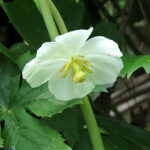 < Mayapples bloom in late spring after many ephemerals have faded. They grow in colonies in forested areas creating a canopy of umbrella-like plants. The plants bear one white flower, which matures into a yellow fruit and can be used to make jam. Harry Potter fans will be pleased to know that this herbaceous perennial is also known as mandrake.
< Mayapples bloom in late spring after many ephemerals have faded. They grow in colonies in forested areas creating a canopy of umbrella-like plants. The plants bear one white flower, which matures into a yellow fruit and can be used to make jam. Harry Potter fans will be pleased to know that this herbaceous perennial is also known as mandrake.
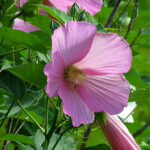 < Swamp Rose-mallow is a showy hibiscus and one of the largest perennials in our area. It can be spotted in wet and boggy areas next to the towpath and along the Canal banks in some areas and has established some large colonies. This is a winter-hardy plant with a decidedly tropical flair. The flower color ranges from white to pink to red with a crimson center and yellow stamen. These plants are host to several butterfly larvae and are a food source for hummingbirds as well.
< Swamp Rose-mallow is a showy hibiscus and one of the largest perennials in our area. It can be spotted in wet and boggy areas next to the towpath and along the Canal banks in some areas and has established some large colonies. This is a winter-hardy plant with a decidedly tropical flair. The flower color ranges from white to pink to red with a crimson center and yellow stamen. These plants are host to several butterfly larvae and are a food source for hummingbirds as well.
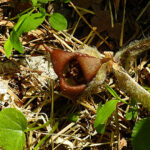 < Wild Ginger is a plant with a lot to offer. It grows in most forested areas and has some interesting adaptations. The flower has three triangular petals, which are hidden beneath heart-shaped leaves. Like the jack-in-the-pulpit, this plant relies on flying insects for pollination. As flies emerge in the spring, they are attracted to the flower, which looks and smells like carrion. The seeds are covered in an oily substance favored by ants who carry the seed back to their colony, eat the oily covering, and plant the seed. Native Americans and early settlers used the dried root of wild ginger as a spice. These plants also contain two antibiotic compounds and were used to make a poultice to treat wounds.
< Wild Ginger is a plant with a lot to offer. It grows in most forested areas and has some interesting adaptations. The flower has three triangular petals, which are hidden beneath heart-shaped leaves. Like the jack-in-the-pulpit, this plant relies on flying insects for pollination. As flies emerge in the spring, they are attracted to the flower, which looks and smells like carrion. The seeds are covered in an oily substance favored by ants who carry the seed back to their colony, eat the oily covering, and plant the seed. Native Americans and early settlers used the dried root of wild ginger as a spice. These plants also contain two antibiotic compounds and were used to make a poultice to treat wounds.
DON’T FORGET TO LOOK UP!
We have many flowering trees in the Delaware Canal state park as well. These include dogwoods, catalpa trees, magnolias, and Tuliptrees or Tulip Poplars. This poplar is fast growing and
can get very large. The trees provide a source of nutrition for many species. The large yellow flowers appear in early summer and are a source of nectar for ruby-throated hummingbirds.
Dogwoods can be seen throughout the park in early spring. They are understory trees, showing off a display of white blooms against the bright green of budding trees. The berries of the dogwood
are a favorite snack of birds and squirrels.
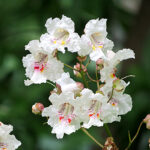 Northern Catalpas are fast-growing showy trees with large heart-shaped tropical-looking leaves. Due in part to its size and its abundant display of flowers, this shade tree has become a popular addition to suburban landscapes. The USDA, however, considers it an invasive weed tree, so if you like the almost wisteria-like blossoms
Northern Catalpas are fast-growing showy trees with large heart-shaped tropical-looking leaves. Due in part to its size and its abundant display of flowers, this shade tree has become a popular addition to suburban landscapes. The USDA, however, considers it an invasive weed tree, so if you like the almost wisteria-like blossoms
and the shade, a regular pruning is recommended.
Do you have a favorite flowering plant in the park?
Let us know, and please send pictures. We love pictures.
SOURCES:
USDA: fs.usda.gov/wildflowers
Bowman’s Wildflower preserve: bhwp.org/grow/native-plant-nursery/native-plant-catalog
High Park Nature Centre: highparknaturecentre.com
PA Enflowered: paenflowered.org
Morton Arboretum: mortonarb.org
PHOTO CREDITS:
Jack in the Pulpit by CCCP: Own work, CC BY-SA 2.5 ca, commons.wikimedia.org/w/index.php?curid=58750771
Wild Ginger courtesy of Fritz Flohr Reynolds, Wikipedia
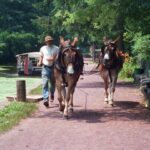 Favored by the founding fathers of our country, the mules established a stellar reputation when they came to the new world. Spanish missions used mules in their western North American missions in the early 1700s. George Washington, an avid farmer, became interested in utilizing mules and imported two male donkeys from Spain to begin a breeding program.
Favored by the founding fathers of our country, the mules established a stellar reputation when they came to the new world. Spanish missions used mules in their western North American missions in the early 1700s. George Washington, an avid farmer, became interested in utilizing mules and imported two male donkeys from Spain to begin a breeding program.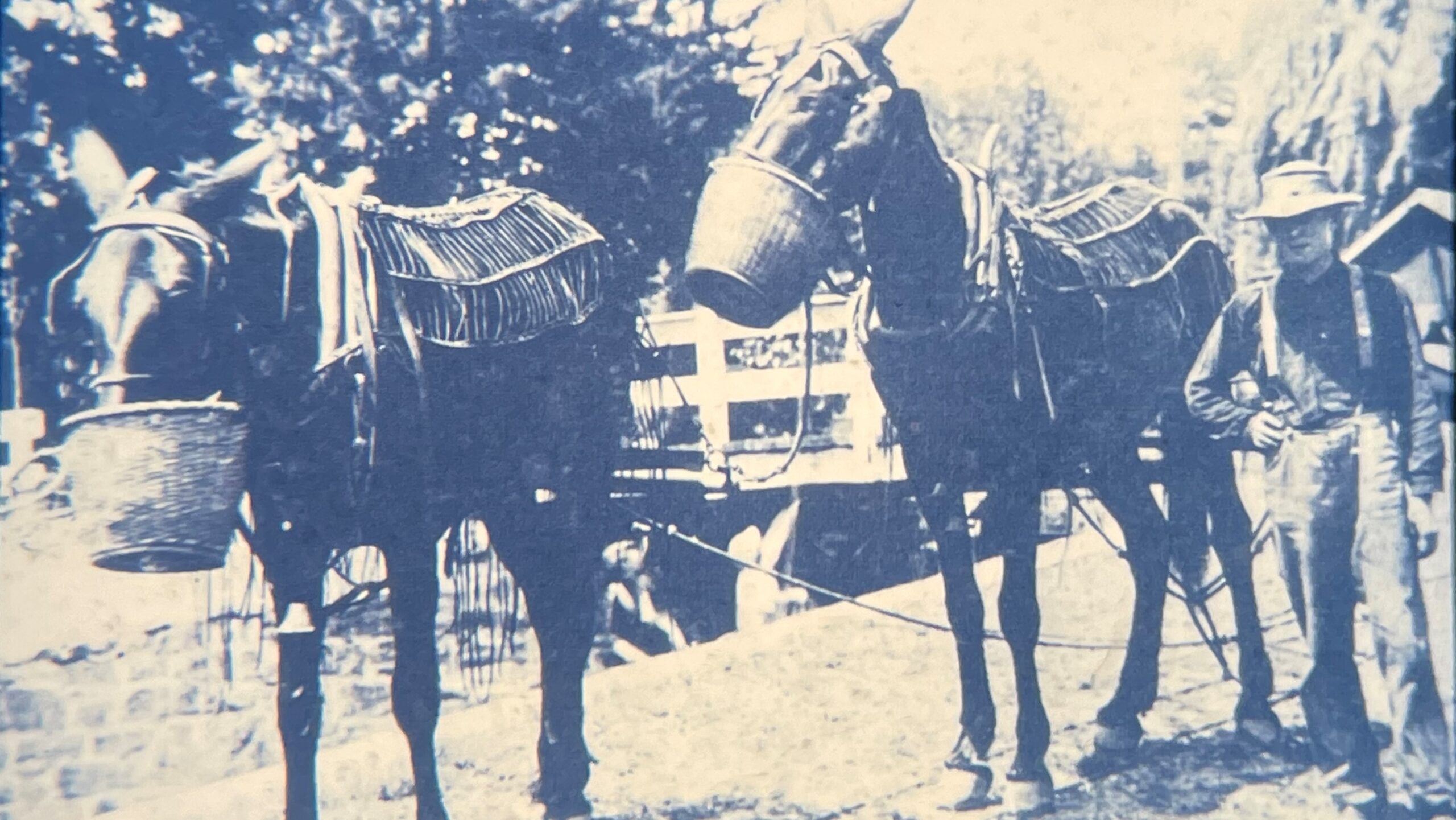 So, when commerce on the Delaware Canal began, mules were the logical choice. From the perspective of the canal boat operator, mules had several distinct advantages. They had a sturdy constitution and were not prone to health problems. They could work long hours, perhaps slower than a horse, but they would keep going. The structure of the mule’s hoof increases its stability, and mules have fewer foot-related problems than horses. And mules seem to be calmer, exhibiting more common sense than a horse. According to author Rinker Buck, who wrote a book about his experience retracing the Oregon Trail in a covered wagon pulled by three mules, “Mules have a larger cranial capacity and thus larger brains than horses—a gift from their feral, burro side—and they ponder things a lot more.”
So, when commerce on the Delaware Canal began, mules were the logical choice. From the perspective of the canal boat operator, mules had several distinct advantages. They had a sturdy constitution and were not prone to health problems. They could work long hours, perhaps slower than a horse, but they would keep going. The structure of the mule’s hoof increases its stability, and mules have fewer foot-related problems than horses. And mules seem to be calmer, exhibiting more common sense than a horse. According to author Rinker Buck, who wrote a book about his experience retracing the Oregon Trail in a covered wagon pulled by three mules, “Mules have a larger cranial capacity and thus larger brains than horses—a gift from their feral, burro side—and they ponder things a lot more.”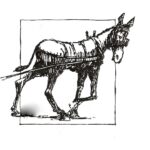
 Something new is brewing at Lock 11 in New Hope. A new exhibition commemorating the140th Birth Anniversary of William Francis Taylor will open in the old concession building next to the Locktender’s House at 145 South Main Street New Hope. The exhibit will provide a chronology of the life and times of Taylor and his contribution to preserving the Delaware Canal and Towpath.
Something new is brewing at Lock 11 in New Hope. A new exhibition commemorating the140th Birth Anniversary of William Francis Taylor will open in the old concession building next to the Locktender’s House at 145 South Main Street New Hope. The exhibit will provide a chronology of the life and times of Taylor and his contribution to preserving the Delaware Canal and Towpath.